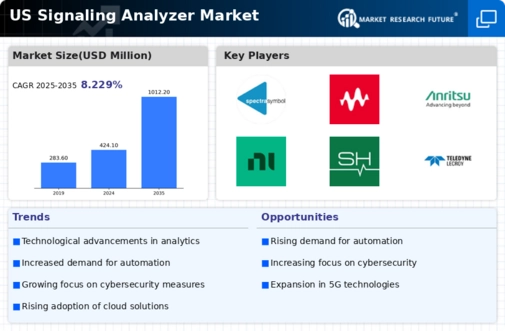Increased Network Complexity
The signaling analyzer market is experiencing growth due to the increasing complexity of network architectures. As organizations adopt advanced technologies such as 5G, IoT, and cloud computing, the need for sophisticated signaling analysis tools becomes paramount. These tools enable network operators to monitor, analyze, and troubleshoot signaling traffic effectively. In the US, the demand for signaling analyzers is projected to rise by approximately 15% annually as companies seek to ensure optimal network performance and reliability. This trend indicates a robust market opportunity for vendors offering innovative signaling analysis solutions, as they cater to the evolving needs of telecommunications and data service providers.
Rising Cybersecurity Concerns
The signaling analyzer market is significantly influenced by the escalating concerns surrounding cybersecurity threats. With the increasing frequency of cyberattacks targeting communication networks, organizations are prioritizing the implementation of advanced signaling analysis tools to detect and mitigate potential vulnerabilities. In the US, the market for signaling analyzers is expected to grow by 20% over the next five years, driven by the necessity for enhanced security measures. These tools provide critical insights into signaling protocols, enabling organizations to identify anomalies and respond swiftly to threats. Consequently, the demand for robust signaling analyzers is likely to surge as businesses strive to protect their networks from malicious activities.
Expansion of Wireless Communication
The expansion of wireless communication technologies is a key driver for the signaling analyzer market. As the US continues to invest in the development of wireless infrastructure, including 5G networks, the need for effective signaling analysis becomes increasingly vital. Signaling analyzers play a crucial role in ensuring seamless communication by monitoring signaling traffic and optimizing network performance. The market is projected to witness a growth rate of 18% annually. This reflects the rising adoption of wireless technologies across various sectors. This trend suggests that signaling analyzers will be indispensable tools for telecommunications providers and enterprises aiming to enhance their wireless communication capabilities.
Growing Demand for Quality Assurance
The growing demand for quality assurance in telecommunications is a significant driver of the signaling analyzer market. As service providers strive to deliver high-quality services, the need for effective signaling analysis tools becomes critical. These tools help in monitoring and ensuring the integrity of signaling messages, which is essential for maintaining service quality. In the US, the market is projected to grow by 12% annually, driven by the increasing emphasis on customer satisfaction and service reliability. This trend suggests that signaling analyzers will play a pivotal role in helping organizations meet stringent quality assurance standards and enhance their competitive edge.
Integration of AI and Machine Learning
The integration of artificial intelligence (AI) and machine learning (ML) technologies into signaling analysis tools is transforming the signaling analyzer market. These advanced technologies enable more efficient data processing and analysis, allowing for real-time insights into network performance. In the US, the adoption of AI-driven signaling analyzers is anticipated to increase by 25% over the next few years, as organizations seek to leverage automation for improved operational efficiency. This trend indicates a shift towards more intelligent signaling analysis solutions, which can adapt to changing network conditions and provide predictive analytics, thereby enhancing overall network management.






















Leave a Comment